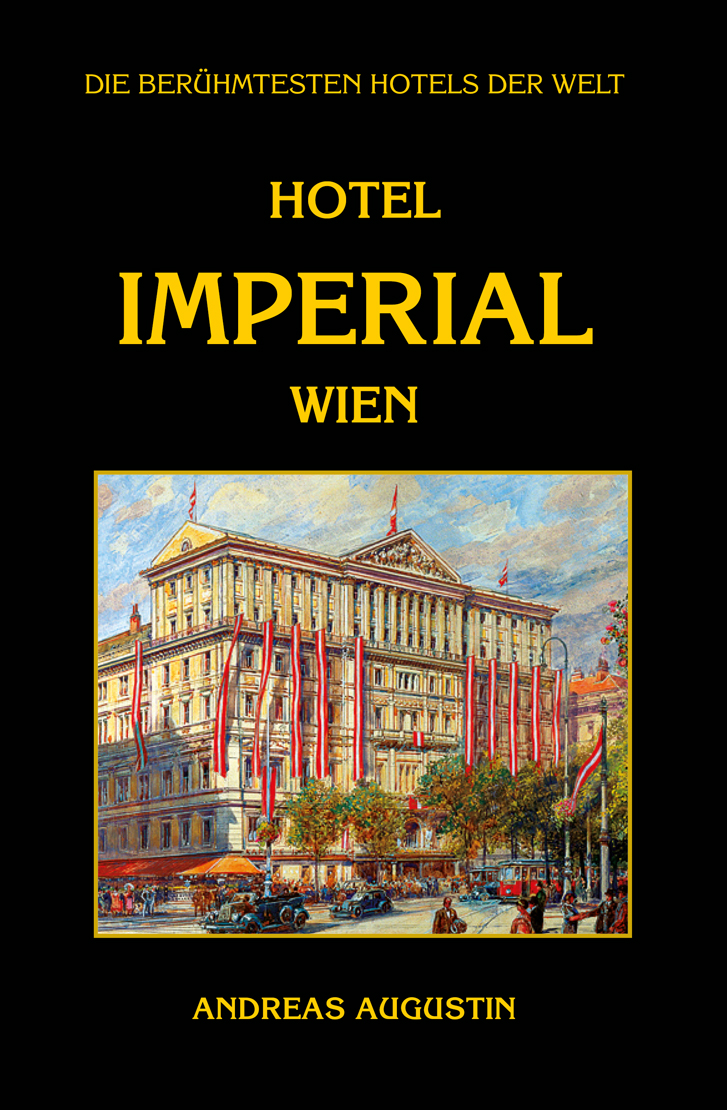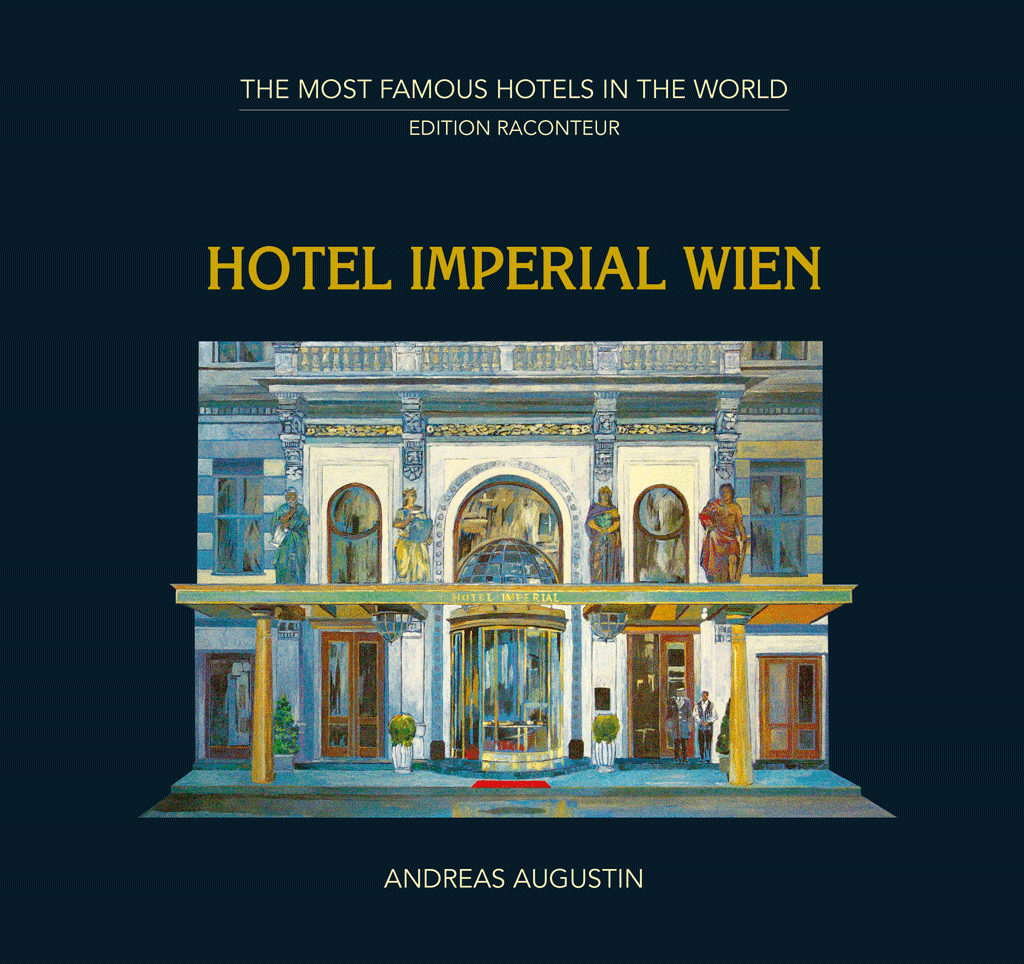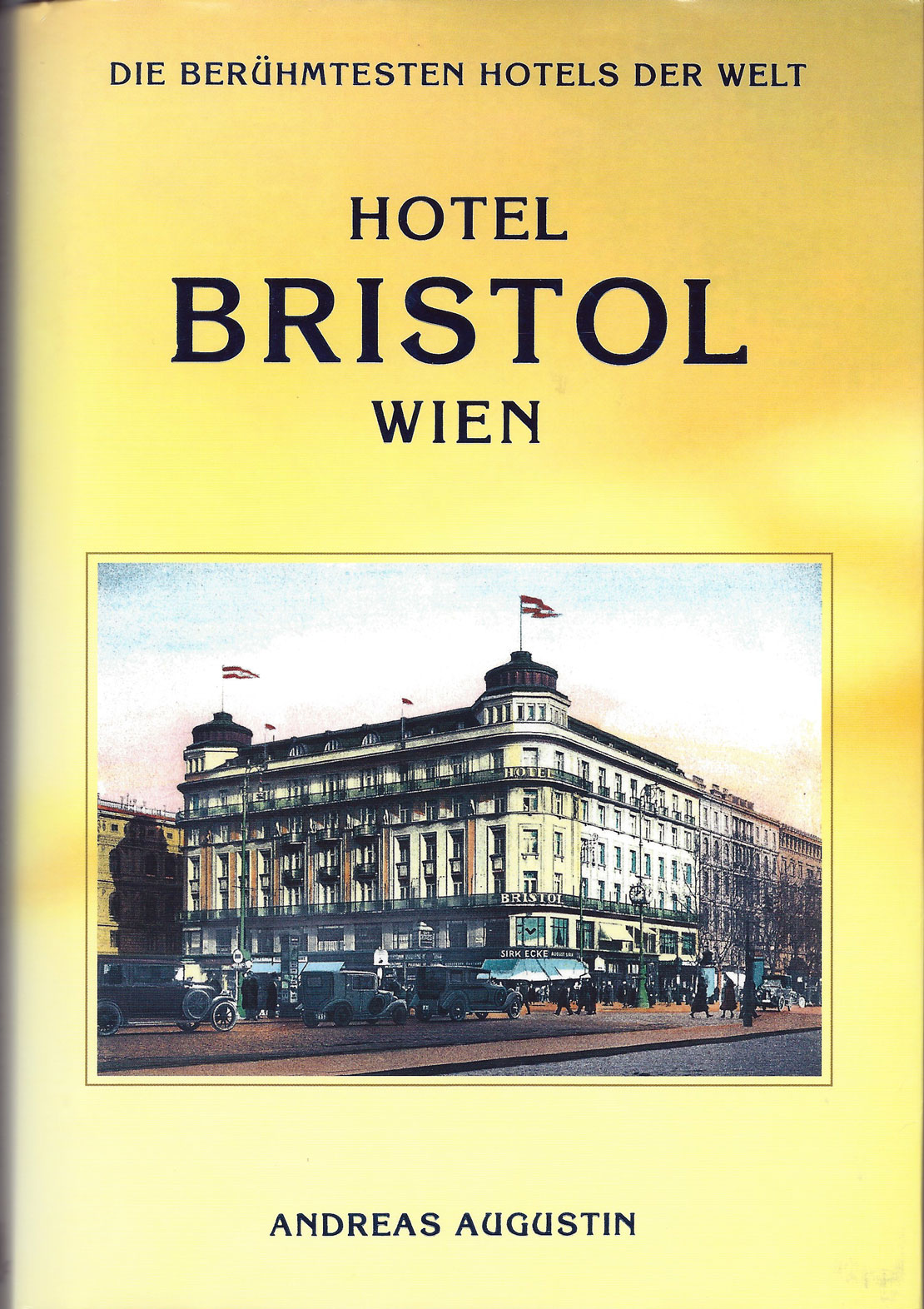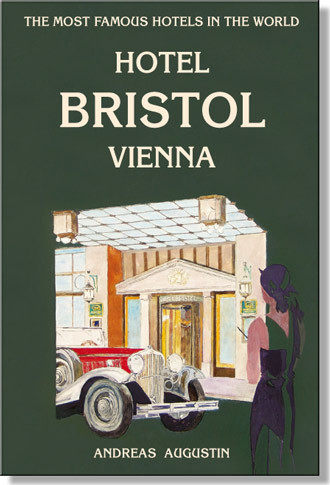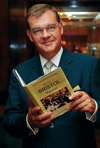Imperial – Vienna, Austria (English)
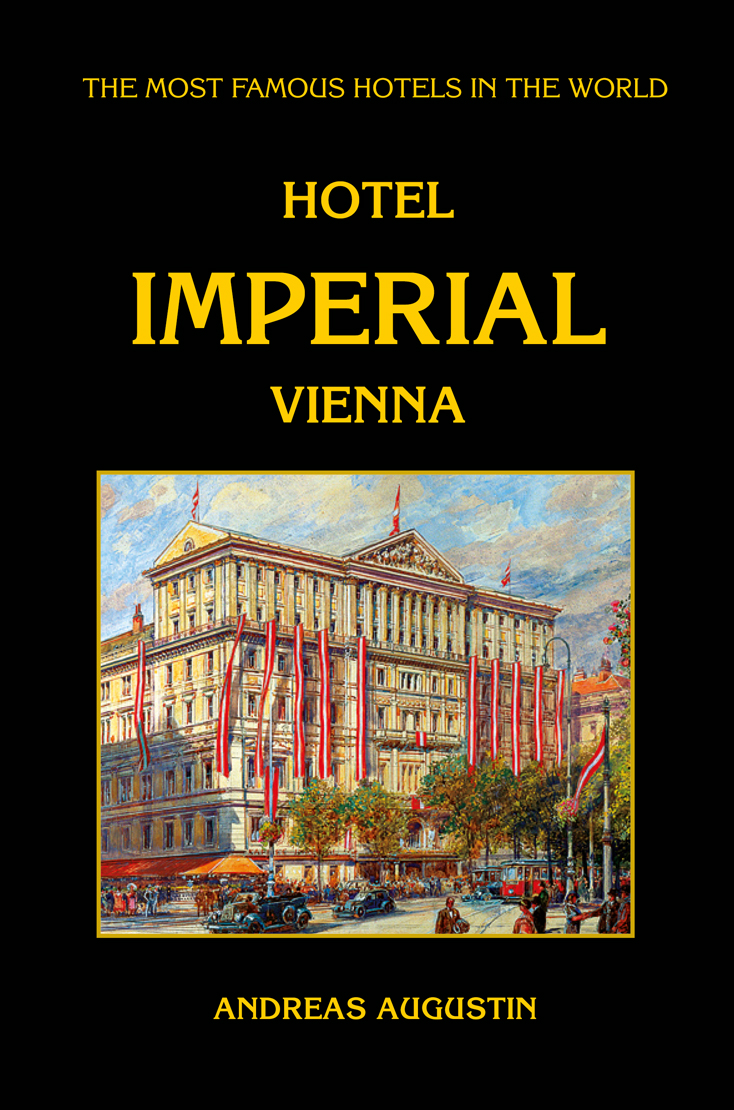
Author
Andreas Augustin
Pages
160
Photographs
Illustrations
Over 220 historic and contemporary photographs by – among others – Bill Lorenz and Jaime Ardiles-Arce
Leather-bound edition
Yes
Binding
Hardcover (real cloth bound / gold stamping / dust jacket)
Includes
2 postcards, 2 reading marks (HIS and HERS)
ISBN
3-900-692-03-3
Size/Weight
160 x 235 mm, 720 g
Related Hotel
Vienna around 1860. A city under construction. Franz Joseph, a young and dynamic emperor, has the Ringstrasse built. One architectural jewel after another glitters around this necklace of stone: the City Hall, the Burgtheater, the Parliament, the Vienna State Opera. Here, too, stands the luxuriously appointed private palace of the Prince of Württemberg. The prince sells his palace, and in 1873 it is converted into a hotel. The Imperial. Its central location, magnificent furnishings and first class management immediately make it Vienna’s leading hotel, the establishment frequented by officials of state, great artists and international travellers. The Imperial’s outstanding cuisine puts it in a league with the finest restaurants on the continent. Richard Wagner lived here for weeks. It was a second home to Bismarck. Charlie Chaplin thought it the finest hotel he had ever lived in, an opinion shared by the Queen of England. All Vienna’s most distinguished visitors have resided at the Imperial, from state visitor to celebrated tenor. When in Austria, they like to stay in the Royal Suite, one of the most beautiful and grandest hotel suites in the world. This is the history of a unique Viennese institution, from the 1870s to the present day; a look behind the scenes of a hotel which for over a century has never ceased to be one of the finest in the world.
A flag flutters majestically high above the Ringstrasse: a state visit is imminent. The red carpet has been rolled out. On either side of the modern revolving door is a wooden sentry box. The two guards are still adjusting their uniforms. ‘Do that button up!’ ‘Thank you! Mind your bootlace!’ ‘OK, now everything’s just right.’ ‘Present arms!’ as the sound of sirens can already be heard in the distance. The ‘White Mice’, as the Viennese refer to their motorcycle policemen, are providing an escort for a convoy of black limousines. Coming from the direction of Schwarzenbergplatz, they cruise round the Ring and turn into the side road. One after another, they stop in front of the Imperial. The doors are flung open, bodyguards leap out to secure a passage where for the inexperienced eye there is nothing to be secured, communicating via almost invisible radio headsets, and looking extremely serious about the whole matter. Wherever state visitors are accommodated, you normally find the formal etiquette of world politics. Not so at the Imperial in Vienna.
The hotel is more than just a home from home for the leading statesman and women of the world. Add to them the names of great personalities from the world of fine arts, and the picture becomes more complete. Toss in a generous portion of inimitable Viennese charm, and the formality of one’s first impression disappears once and for all. The general manager of the hotel bows deeply, welcoming his esteemed visitor who is escorted to the Royal Suite on the first floor. On his way up the stairs, the visitor pauses for a moment. It is unusual to find so much splendour in a hotel. High above him, at the end of the staircase, stands a man. His Majesty, Emperor Franz Joseph, complete with hat, sword and gloves, gazing down curiously from his gilded frame at the new arrival. A magnificent figure. It is easy to believe that he had the strength to rule over an empire of 52 million people. Beneath them, two Graces flank the statue of the Danube nymph. Everything is chiselled in stuccolustro. Even Kings commented that never before had they been accommodated ‘so royally’ in a hotel. Outside on the Ring there is no longer any sign of all the fuss and bother. The black limousines have pulled away.
The flags above the Austrian Republic’s grandest boulevard continue to flutter in the wind. The magnificent buildings round about symbolise the old Austro-Hungarian monarchy and the New Republic. Slowly, one is lost in the magic of an imperial age. One’s thoughts go back to an age when an Emperor lived in this city, ruling over one of the world’s mightiest empires. An empire that must certainly have been the most European of all the European empires, rooted as it was in every corner of the continent, uniting all the nations of Europe. This is a concept that has always been held in high esteem here in Vienna.
Andreas Augustin
By 1998 our series of books about historic hotels (modestly started with Singapore's Raffles in 1986) had grown into a 'library of hospitality'. 'The Most Famous Hotels in the World' had become an established brand. From researchers and authors we had become consultants, developers and strategic planners. Identified as a sustainable asset, history had grown into a major marketing tool. In 1999, almost 300 hotels were listed all over the world. Meanwhile, famoushotels.org was officially an organisation.
At that point we met Erhard Noreisch, General Manager of the Imperial Austria AG and Vice President of Sheraton East- and Central Europe (left). In this position he was in charge of the most established Austrian hotel, the Imperial. He was also managing – with a hotel manager - the Bristol. He liked the idea of having books about the history of these two hotels, both Viennese institutions of the highest order. The hotels had a rich history, but nothing had been collated. However, the archives were in the city and a priceless collection of material awaited us at the hotel itself. Being called in to produce a book about a hotel which has a 'well established' history sounds like a piece of cake. We even found a photograph of the actual construction of the hotel. But sometimes the proven legends lead to unexpected surprises. Is everybody happy to accept the truth, when we discover that distributed facts are not correct? This affects marketing strategies; sometimes entire advertising campaigns have to be pulped. General managers certainly have different ways of reacting.
The Imperial Connection: Legend had it that the Imperial in 1873 had been personally opened by the Austrian Emperor himself, who bestowed the honour of the Imperial name upon the hotel. The Bristol, the other hotel in the chain, had opened in 1892 and got its name from nobody less than the Earl of Bristol, who considered it worthy of bearing his aristocratic name. Good stories to start with. But were they true or had they simply supplied good PR for over a century? We expressed our doubts. Without hesitating, General Manager Erhard Noreisch gave us carte blanche to do the necessary research ...
Upon starting this exciting adventure, Petra Engl-Wurzer, the director of public relations for both hotels, opened the archives for us. With Petra, who holds a PhD in Public Relations, Journalism and Communication, we would develop a series of new gadgets for the hotel industry, that made the life of travelling journalists a lot easier. One of them was the Traveller's Notepad, a digital press kit that revolutionised the classic hotel's press kit. This system made the work of thousands of journalists easier every year. But back to square one. Records had been either kept in the hotel's safe or saved by thoughtful minds. One of them was chief concierge Michael Moser, a treasure trove of good anecdotes and a splendid conversation partner. Many a rare document has been saved by his hands, pulling it out from bins at the last moment, rescuing it from careless office staff with little sense of history. In the safes of the hotel guest books from the early 20th century had been kept in good shape, bearing the signatures of some of the most notable figures in history.
Hotel anecdotes spanned from the visit of the German Prince Bismarck to that of the composer Richard Wagner. The photographic archives released rare documents from the sojourns of Her Majesty, Queen Elizabeth of England and the Shah of Persia. And in Vienna history is alive: we found a cameraman whose father had shot Charlie Chaplin's arrival and a room-service waiter who once served the Soviet leader Kruschev. Also very much alive was the legend that His Imperial Highness, Emperor Franz Joseph personally opened the hotel. It was published in various advertisements and a solid cornerstone of the hotel's PR line. Again we dug deep. We searched the public archives, wanting to confirm the event with some hard facts. We checked the diaries of the imperial court: no trace of the emperor being close to the Imperial that day. In fact, he wasn't there for years. And he had nothing to do with the name giving. The name was French, which was the lingua franca of the upper class at the time. Maybe it was meant to be English, but certainly not German. The German version would have been Kaiser or kaiserlich like in Kaiserhof. His Apostolic Majesty, Emperor Franz Joseph personally crowned the hotel some years later, in 1879, with an 'imperial' visit. Prince Bismarck was in the city at the time discussing an alliance with Count Andrássy of Hungary in one of the parlours on the second floor. Only then did Franz Joseph choose to go to the Imperial – a mark of great respect to his honoured guest. We presented the new facts to the management. Erhard Noreisch and Petra Engl-Wurzer realised the consequences: changes to the existing PR and advertising lines. The sentence 'Opened by the Emperor . . . ' had to be dropped. They chose the truth and got many other great stories in return. This makes the first sentence on the copyright- and thank-you page of the Imperial Vienna book much easier to understand: 'It must be noted with the greatest respect that the management of the hotel decided to accept historical facts rather than old legends and traditionally distributed myth.' The resulting book in its fifth edition is still growing year by year. Every now and again we find new anecdotes around the coffee house and its intellectual clientele. Only recently we stumbled over the photographs of Jakob Tuggener, who left us priceless pictures from the night of a big ball at the hotel in the 1950s. So, you see, history never stops. It is an ongoing affair ...
Andreas Augustin
presents
Hotel Imperial Vienna
in the series The Most Famous Hotels in the World™
updated edition 2003/4
The author and the organisation The Most Famous Hotels in the World™, would like to especially thank Erhard Noreisch, General Manager of the Imperial Hotels Austria AG and Senior Vice President of Starwood Hotel & Resorts Central Europe.
It must be noted with greatest respect that the management of the hotel decided to accept historical facts rather than old legends and traditionally distributed myth.
We thank Thomas Schön, General Manager of the hotel, for his support. Petra Engl-Wurzer, in charge of Public Relations of the group, is coaching this ongoing project with all its updated editions with much professional care and personal enthusiasm.
We also thank Michael Hatzfeld, the former manager, Andreas Bienenstein, Heidar Fityani, Harald Hitner, Sylvester Huber, Andrea Konert and Philip S. Rosenstingl. We treasure the memories of the late Franz-Josef Macho.
Josef Prosek, the Financial Director of the group, gave us commercial, the chefs Stefan Hierzer and Siefried Kröpfl culinary lessons. Concierge Michael Moser deserves our gratitude for never getting tired answering all sorts of questions and being such a valuable companion in preserving the history of this unique hotel.
Assistants historic research: Andrew Williamson (London), Marcello de la Speranza (Vienna)
Photographs: Bill Lorenz, Archives of the Hotel Imperial (Jaime Ardiles-Arce, David Peters, Fotozentrum K. Reiberger, Atelier Doris Kucera, pictures born - H. Nessler, Thomas Vockenhuber Photography Vienna, Matthias Hamel u.a.) Archives of the Austrian National Library, Archives Dr. M. La Speranza, Vienna Famous Hotels Main Archives, Musikverein – Peter Schramek and the private collection of Hedi Graf. The private collection of Professor Adolf Frohner and his family – descendants of the great Imperial hotelier Johann Frohner – were of greatest value.
Production: Carola E. Augustin, Daniel Szelényi
Editor: Thomas Cane
All historic data has been carefully selected during research with the objective of providing a general historical overview. This work does not therefore claim to be complete. Historic photographs have been restored and coloured as necessary, and are therefore subject to copyright. The entire work, including such parts as the dust jacket, the enclosed postcards and bookmarks, are also subject to copyright. Any form of storage using electronic media or distribution via a network is prohibited. Any reproduction of excerpts from this work without the explicit written consent of The Most Famous Hotels in the World™ will be prosecuted.
Note for publishers and authors
We have developed the digital press kit TRAVELLER’S NOTE PAD, where over 100 photographs used in this book are available as high-quality digital files. Please contact the archives of The Most Famous Hotels in the World and ask for optimal illustrations for your own publications. We will be happy to provide them for you.

